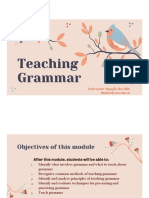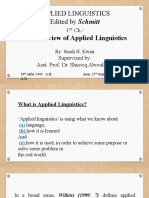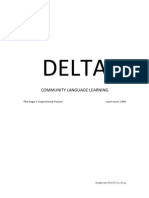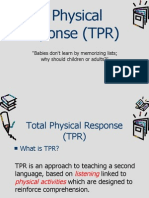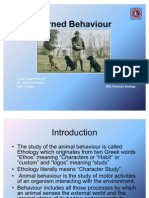Differences Between Audio Lingual and Communicative Language Teaching Methods
Differences Between Audio Lingual and Communicative Language Teaching Methods
Uploaded by
watanorikoCopyright:
Available Formats
Differences Between Audio Lingual and Communicative Language Teaching Methods
Differences Between Audio Lingual and Communicative Language Teaching Methods
Uploaded by
watanorikoOriginal Description:
Copyright
Available Formats
Share this document
Did you find this document useful?
Is this content inappropriate?
Copyright:
Available Formats
Differences Between Audio Lingual and Communicative Language Teaching Methods
Differences Between Audio Lingual and Communicative Language Teaching Methods
Uploaded by
watanorikoCopyright:
Available Formats
Differences Between Audio Lingual and Communicative language teaching Methods
The audio lingual method, or the Army method, or also the New key, is the mode of language instruction based on behaviourist ideology, which professes that certain traits of living things could be trained through a system of reinforcement. The instructor would present the correct model of a sentence and the students would have to repeat it. The teacher would then continue by presenting new words for the students to sample in the same structure. There is no explicit grammar instruction everything is simply memorized in form. The idea is for the students to practice the particular construction untill they can use it spontaneously. In this manner, the lessons are built on static drills in which the students have little or no control on their own output.
The communicative language teaching is am approach to the teaching of second and foreign languages that emphasizes communication or interaction as both the means and the ultimate goal of learning a language. The clt was the product of educators and linguists who had grown dissatisfied with earlier Grammer Translation and Audio Lingual Methods, where students were nott learning enough realistic, socially necessary language. Therefore they became interested in the development of communicative style teaching in the 1970s, focussing on authentic language use and classroom exchanges where students engaged in real communication with one another. The goal of clt is of creating communicative competence in the learners. It makes use of real life situations.
The CLT and ALM differ from various aspects. Basic differences as presented by Finocchiaro and Brumfit(1983) are given below:
Meaning and structure
CLT: Meaning is paramount.
ALM: Attends to structure and form more than meaning.
Ccontext
CLT: Contextualization is a basic premise.
ALM: Language items are not necessarily contextualized.
Learning objectives
CLT: Language learning is learning to communicate.
ALM: Language Learning is learning structures, sounds or words.
Goal
CLT: Effective communication is sought.
ALM: Mastery or "overlearning" is sought.
Drilling
CLT: Drilling may occur, but peripherially.
ALM: Drilling is a central technique.
Pronunciation
CLT: Comprehensible pronunciation is sought.
ALM: Native-speaker-like pronunciation is sought.
Grammatical explanation
CLT: Any device which helps the learners is accepted - varying according to their age, interest, etc.
ALM: Grammatical explanation is avoided.
STAGE OF COMMUNICATIVE ACTIVITIES
CLT: Attempts to communicate may be encouraged from the very beginning.
ALM: Communicative activities only come after a long process of rigid drills and exercises.
Native language
CLT: Judicious use of native language is accepted where feasible.
ALM: The use of the learners' native language is forbidden.
Translation
CLT: Translation may be used where learners need or benefit from it.
ALM: Translation is forbidden at early levels.
Reading and writing
CLT: Reading and writing can start from the first day, if desired.
ALM: Reading and writing are deferred until speech is mastered.
Teaching Patterns
CLT: The target linguistic system will be learned best through the process of struggling to communicate.
ALM: The target linguistic system will be learned through the overt teaching of the patterns of the system.
Competence
CLT: Communicative competence is the desired goal.
ALM: Linguistic competence is the desired goal.
Language variation
CLT: Linguistic variation is a central concept in materials and methods.
ALM: Varieties of language are recognized but not emphasized.
Sequencing
CLT: Sequencing is determined by any consideration of content function, or meaning which maintains interest.
ALM: The sequence of units is determined solely on principles of linguistic complexity.
Error
CLT: Language is created by the individual often through trial and error.
ALM: "Language is habit" so error must be prevented at all costs.
Accuracy
CLT: Fluency and acceptable language is the primary goal: accuracy is judged not in the abstract but in context.
ALM: Accuracy, in terms of formal correctness, is a primary goal.
Intrinsic motivation
CLT: Intrinsic motivation will spring from an interest in what is being communicated by the language.
ALM: Intrinsic motivation will spring from an interest in the structure of the language.
Teacher's function
CLT: Teachers help learners in any way that motivates them to work with the language.
ALM: The teacher controls the learners and prevents them from doing anything that conflict with the theory.
Interaction
CLT: Learners are expected to interact with other people, either in the flesh, through pair and group work, or in their writings.
ALM: Learners are expected to interact with the language system, embodied in machines or controlled materials.
Learner Laguage
CLT: The teacher cannot know exactly what language the learners will use.
ALM: The teacher is expected to specify the language that learners are to use.
Teachers' responsibility
CLT: The teachers assume a responsibility for determining and responding to learner's language need.
ALM: The teachers have no responsibility to determine learner's language need.
Communicative language teaching often uses a functional-notional syllabus. A notional-functional syllabus is more a way of organizing a language learning curriculum than a method or an approach to teaching. On the other hand, Audiolingualism is a linguistic, or structure based approach to language teaching. The starting point is a linguistic syllabus which contains the key items of phonology, morphology, and syntax of the language arranged according to their order of presentation.
Instructional materials:
In communicative language teaching, instructional materials have the primary role of promoting communicative language use. In audio-lingual method, instructional materials assist the teacher to develop language mastery in the learner.
You might also like
- SALDA Blanks Level of QuestioningDocument4 pagesSALDA Blanks Level of Questioninggurriaali100% (1)
- Transfer of LearningDocument15 pagesTransfer of LearningAna Devero75% (4)
- Teaching Grammar: Fe T. CanoyDocument28 pagesTeaching Grammar: Fe T. CanoyFe Canoy0% (1)
- Silent WayDocument9 pagesSilent WayPiotr LorekNo ratings yet
- First Language AcquisitionDocument27 pagesFirst Language AcquisitionDita WithalotofluvNo ratings yet
- TheNewestCodeNLP PDFDocument12 pagesTheNewestCodeNLP PDFPutu Yudiantara100% (2)
- Personality TypesDocument70 pagesPersonality TypeswhitepaladinNo ratings yet
- TestDocument16 pagesTestomnicorCCPNo ratings yet
- Advantages of CLT in EFL ClassroomDocument2 pagesAdvantages of CLT in EFL ClassroommuymursinahNo ratings yet
- Methods and Approaches - QuizDocument3 pagesMethods and Approaches - QuizIoanna Jane AndreopoulouNo ratings yet
- How To Teach Grammar Using PPP ModelDocument3 pagesHow To Teach Grammar Using PPP ModelThao NguyenNo ratings yet
- TheoryDocument5 pagesTheoryMohammad Jahidul IslamNo ratings yet
- Unit 6: Syllabus Design: Module 1 (1 of 1)Document3 pagesUnit 6: Syllabus Design: Module 1 (1 of 1)Sheethal Sarma100% (1)
- Critical Period HypothesisDocument12 pagesCritical Period HypothesisMohamed SaidNo ratings yet
- Vocabulary Learning Strategy Use and Vocabulary ProficiencyDocument18 pagesVocabulary Learning Strategy Use and Vocabulary ProficiencynoraNo ratings yet
- Direct Method 5 TechniquesDocument9 pagesDirect Method 5 TechniquesAlexandru Lupu100% (1)
- The Direct MethodDocument3 pagesThe Direct MethodManu MelgarNo ratings yet
- Complete Direct MethodDocument7 pagesComplete Direct MethodSonia Zamo GarNo ratings yet
- Key Terms in ELTDocument10 pagesKey Terms in ELTSalsabeel Nagi100% (1)
- Qualities of A Good Teacher and Techniques in Teaching Maryam BaigDocument7 pagesQualities of A Good Teacher and Techniques in Teaching Maryam Baigapi-310691943No ratings yet
- Adapting and Selecting Instructional Materials in EnglishDocument43 pagesAdapting and Selecting Instructional Materials in EnglishclytielejardeNo ratings yet
- 490354the Oral Error Correction Techniques Used by Libyan Secondary School Teachers of English Muhsen Abobaker A. Ali ADocument315 pages490354the Oral Error Correction Techniques Used by Libyan Secondary School Teachers of English Muhsen Abobaker A. Ali ALouis WilliamNo ratings yet
- Communicative Approach To Language Teaching PDFDocument2 pagesCommunicative Approach To Language Teaching PDFAdamNo ratings yet
- Anthology Review Pedagogical GrammarDocument17 pagesAnthology Review Pedagogical Grammarapi-201107267No ratings yet
- Exploring Methods and Approaches in ELTDocument14 pagesExploring Methods and Approaches in ELTMary Jay Sismar - IsraelNo ratings yet
- Week 5 Type and Shapes of SyllabusDocument32 pagesWeek 5 Type and Shapes of Syllabustiffani rahmarNo ratings yet
- The Direct Method of Teaching EnglishDocument7 pagesThe Direct Method of Teaching EnglishVisitacion Sunshine BaradiNo ratings yet
- The Audio Lingual MethodDocument39 pagesThe Audio Lingual MethodThao VuNo ratings yet
- Teaching GrammarDocument29 pagesTeaching GrammarThu Phương100% (1)
- The Audio-Lingual Method Definition:: Approach Design ProcedureDocument3 pagesThe Audio-Lingual Method Definition:: Approach Design ProcedureHà Thủy QuỳnhNo ratings yet
- Assessing Listening A. Observing The Performance of The Four SkillsDocument6 pagesAssessing Listening A. Observing The Performance of The Four SkillsEka NWNo ratings yet
- Language Syllabus TypesDocument16 pagesLanguage Syllabus Typespelangiuntukizul100% (2)
- Developing Speaking SkillsDocument2 pagesDeveloping Speaking SkillsJalal Nasser SalmanNo ratings yet
- Electic Approach 2Document2 pagesElectic Approach 2iramshakoorNo ratings yet
- What Is Contrastive AnalysisDocument10 pagesWhat Is Contrastive AnalysisTanja PeljevicNo ratings yet
- Lesson Plan Viii Passive Voice FinalDocument5 pagesLesson Plan Viii Passive Voice FinalDiana GhebanNo ratings yet
- Grammar Translation MethodDocument4 pagesGrammar Translation MethodnilsusudeNo ratings yet
- Overview of Language Policy and Practice in EducationDocument14 pagesOverview of Language Policy and Practice in EducationKarl Lennard CortezNo ratings yet
- Methods, Procedure and Technique of Teaching LanguageDocument28 pagesMethods, Procedure and Technique of Teaching LanguageAngellete GopezNo ratings yet
- Audio Lingual MethodDocument12 pagesAudio Lingual MethodKeviin Mariño VivasNo ratings yet
- Ellt Methods and ApproachesDocument53 pagesEllt Methods and ApproachesFabian TorresNo ratings yet
- CH 1 Schmitt - An Overview of ALDocument75 pagesCH 1 Schmitt - An Overview of ALzaNo ratings yet
- Overview of Language Teaching MethodologyDocument19 pagesOverview of Language Teaching Methodologyapi-316763559No ratings yet
- History of Language TeachingDocument14 pagesHistory of Language TeachingRia RarasatiNo ratings yet
- Direct MethodDocument14 pagesDirect Methodapi-321172081No ratings yet
- Community Language LearningDocument10 pagesCommunity Language Learningnewtonzworld100% (2)
- Total Physical Response (TPR) - 2Document16 pagesTotal Physical Response (TPR) - 2ydanie100% (1)
- Teaching and Testing GrammarDocument2 pagesTeaching and Testing GrammarRaquel LimboNo ratings yet
- Materials For Teaching GrammarDocument18 pagesMaterials For Teaching GrammarKit Oseias H. Castillo100% (1)
- Syllabus DesignDocument18 pagesSyllabus DesignAnonymous Wj6Bhcbw100% (1)
- Unit 1Document28 pagesUnit 1Song Ji HyoNo ratings yet
- What Is The Grammar Translation MethodDocument6 pagesWhat Is The Grammar Translation MethodNguyễn ĐăngNo ratings yet
- Language TestsDocument16 pagesLanguage TestsThu Anh NgôNo ratings yet
- Pre SILENT WAY METHODDocument19 pagesPre SILENT WAY METHODMishil Laspobres CarillasNo ratings yet
- Language Policy and Planning For Developing CountriesDocument13 pagesLanguage Policy and Planning For Developing CountriesZia Mahmud Khan RatulNo ratings yet
- Grammar PedagogyDocument19 pagesGrammar PedagogyAzhar Munir100% (1)
- Weaknesses of Grammar Translation MethodDocument1 pageWeaknesses of Grammar Translation Methodhuyenvu16020950% (2)
- Language Teaching and LearningDocument22 pagesLanguage Teaching and Learningbtorres_49394No ratings yet
- What Is Desuggestopedia?Document4 pagesWhat Is Desuggestopedia?sandhorac7453100% (1)
- The Nature of Listening SkillsDocument12 pagesThe Nature of Listening SkillsIlham IsmailNo ratings yet
- Direct Method A Paper Presented To Fulfill The Requirement of The Task of Tefl Metodology 1Document14 pagesDirect Method A Paper Presented To Fulfill The Requirement of The Task of Tefl Metodology 1vinna naralita100% (1)
- Reading SkillsDocument25 pagesReading SkillsDaffodilsNo ratings yet
- Community Language Learning 2011Document33 pagesCommunity Language Learning 2011Valeria Roldán100% (2)
- The Communicative Language Teaching ApproachDocument5 pagesThe Communicative Language Teaching ApproachparsarouhNo ratings yet
- Using Games To Enhance Oral Communication in Upper Primary SchoolDocument15 pagesUsing Games To Enhance Oral Communication in Upper Primary SchoolAzizan ShafieNo ratings yet
- Psychological Foundation PDFDocument52 pagesPsychological Foundation PDFJohe Gunsin100% (1)
- SylvieDocument2 pagesSylvieapi-301812560No ratings yet
- Learned Behaviour SeminarDocument20 pagesLearned Behaviour SeminarNishita Sharma100% (1)
- Ausubel Subsumption TheoryDocument5 pagesAusubel Subsumption TheoryJasmine Loo100% (1)
- Background of StudyDocument4 pagesBackground of StudyAchmad Jerry RizkyNo ratings yet
- Different Purposes of ReadingDocument6 pagesDifferent Purposes of ReadingLuthfi Zodiacsagitarius0% (1)
- Teaching Strategies and Methodologies For Teaching and LearningDocument52 pagesTeaching Strategies and Methodologies For Teaching and LearningTomNo ratings yet
- Book Review On The Mozart Effect For Children: Awakening Your Child's Mind, Health, and Creativity With MusicDocument3 pagesBook Review On The Mozart Effect For Children: Awakening Your Child's Mind, Health, and Creativity With MusicVJoy RT100% (1)
- Sense PerceptionDocument18 pagesSense PerceptionUrska AnumanchiNo ratings yet
- Traditional Teaching StrategiesDocument1 pageTraditional Teaching StrategiesLoi Ocampo Crespo100% (1)
- EQ and IQDocument2 pagesEQ and IQvinaysavaniNo ratings yet
- Linguistic CompetenceDocument11 pagesLinguistic CompetenceRusti2012No ratings yet
- Cognitive Psychology: Kendra Cherry A Board-Certified PhysicianDocument3 pagesCognitive Psychology: Kendra Cherry A Board-Certified PhysiciansrimkbNo ratings yet
- Physical Learning Environme NT: By: Annaliza D. SonDocument6 pagesPhysical Learning Environme NT: By: Annaliza D. SonCesarNo ratings yet
- Human Computer Interaction: Week 2 UsersDocument26 pagesHuman Computer Interaction: Week 2 UsersCarvino Iqbal HendyNo ratings yet
- Superbrain Yoga PDFDocument6 pagesSuperbrain Yoga PDFFundacion IzcalloNo ratings yet
- Schema Theory HandoutDocument3 pagesSchema Theory HandoutDinoDemetilloNo ratings yet
- Uself Emotional SelfDocument40 pagesUself Emotional SelfSophia Timbreza100% (1)
- OBC Skills ListDocument1 pageOBC Skills ListdayalNo ratings yet
- Creativity and InnovationDocument3 pagesCreativity and InnovationSaloni JainNo ratings yet
- Scordo Writing ObjectivesDocument3 pagesScordo Writing ObjectivesSharmane SantiagoNo ratings yet
- The Relationship Between Language and ThoughtsDocument5 pagesThe Relationship Between Language and ThoughtsAnonymous hkgEDw8No ratings yet
- LISTENING Correlation Between Listening and PronunciationDocument8 pagesLISTENING Correlation Between Listening and Pronunciationdani.rokoroko07No ratings yet
- Learning and MemoryDocument5 pagesLearning and MemoryReina100% (1)




























